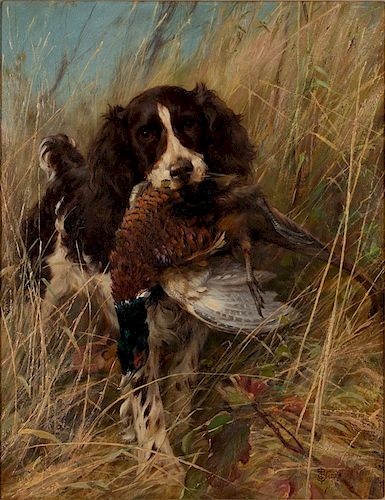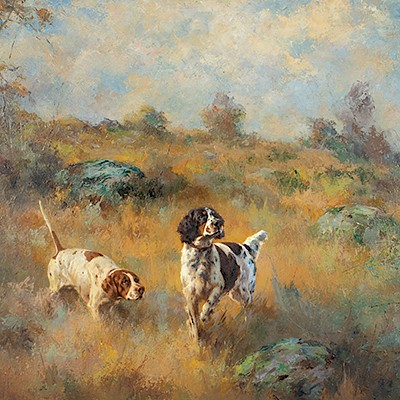Thomas Blinks (English, 1860-1912) English Springer Spaniel with Pheasant
About Seller
20 Winter Street
Pembroke, MA 02359
United States
Founded in 2005, Copley Fine Art Auctions is a boutique auction house specializing in antique decoys and American, sporting, and wildlife paintings. Over the course of the last two decades, the firm has set auction records for not only individual decoy makers, but also entire carving regions. Copley...Read more
Two ways to bid:
- Leave a max absentee bid and the platform will bid on your behalf up to your maximum bid during the live auction.
- Bid live during the auction and your bids will be submitted real-time to the auctioneer.
Bid Increments
| Price | Bid Increment |
|---|---|
| $0 | $50 |
| $1,000 | $100 |
| $2,500 | $250 |
| $5,000 | $500 |
| $10,000 | $1,000 |
| $25,000 | $2,500 |
| $50,000 | $5,000 |
About Auction
Feb 15, 2020
Charleston Marriott, 170 Lockwood Blvd., Charleston, SC 29403 Copley Fine Art Auctions cinnie@copleyart.com
- Lot Description
Thomas Blinks (English, 1860-1912)
English Springer Spaniel with Pheasant
signed "TBlinks" lower right
oil on canvas, 18 by 14 in.
This painting was Robert Montgomery’s favorite portrait of this breed, and may be the most significant painting representing the breed in this golden era of sport. About this painting, a 1938 catalog from The Sporting Gallery and Bookshop states, "Pictures by Thomas Blinks are hard to come by and it is seldom that you will find ones that are so completely pleasing as these...In spite of the fact that they were painted over thirty years ago their treatment and style is so fresh that one might think they had been done yesterday."
Robert Montgomery (1904-1981), born Henry Montgomery Jr., in Fishkill, New York, was a son of industrialist Henry Montgomery, president of the New York Rubber Company. When the family’s fortune was lost during the Depression, Montgomery and his brother Donald tried many jobs to stay afloat. Robert went to New York City to find work as a screen writer, and he tried his luck at stage acting. He appeared in his first film in 1929. Two years later, Norma Shearer chose him to be her leading man in “Private Lives," cementing his status as a movie star.
His career progressed through many prominent roles in film and television. He also became a writer, director, and producer. Montgomery served as president of the Screen Actors Guild for two stretches, interrupted by his service in the U.S. Navy during World War II, where he saw action in both Europe and the Pacific. After the war in 1945, he co-starred with John Wayne in “They Were Expendable." He subsequently left MGM to become an independent director, and producer, with his own popular show, “Robert Montgomery Presents" from 1950 until 1957. His daughter, Elizabeth, was a successful actress who played Samantha Stevens on "Bewitched" for eight years. His only son, Robert "Skip" Montgomery Jr., also became a successful film actor.
In addition to his career, Robert Montgomery was a sportsman, as well as a breeder and fancier of imported English Springer Spaniels, the most prominent breed of sporting field dogs during the Golden Era of Sport. The breed was featured in trials on the palatial estates of the gold coast of Long Island, Fishers Island, as well as in Henry L. Ferguson’s “The English Springer Spaniel in America," published by The Derrydale Press in 1932. Major American artists of the era were commissioned by owners to paint their dogs, including Percival Rosseau (1859-1937), Edwin Megargee (1883-1958), Marguerite Kirmse (1885-1954), and English sporting artists, notably Thomas Blinks (1853-1910).
Thomas Blinks was a self-taught English artist who flourished during the Victorian era. He was popular during his lifetime, exhibiting twenty-nine paintings at the Royal Academy in London between 1883 and 1910, and many of his dynamic hunt scenes and dog portraits were made into prints. Blinks studied horses and their characteristic movements on the grounds of Tattersalls, a horse auction company dating from 1766, and his highly realistic paintings display keen observation and a skilled hand. His works can be found in the Royal Collection, London, among other institutions.
Provenance: Robert Montgomery Collection
The Sporting Gallery and Bookshop, Inc.
Literature: "The Sportsman's Miscellany," The Sporting Gallery and Bookshop, New York, 1938, p. 37, illustrated.
Sotheby's, "The Countryside Alliance, North American Chapter, New York Auction," New York, Wednesday, November 14, 2001, illustrated on cover.
"Spaniels in the Field," Summer 1995, Vol. 15, No. 3, illustrated on cover.
Exhibited: New York, New York, The Sporting Gallery and Bookshop, Inc., 1938.
New York, New York, The Crossroads of Sport, 1940.
New York, New York, The Sportsman’s Gallery, 1946.
New York, New York, Abercrombie & Fitch, 1948.
New York, New York, The Sportsman’s Edge, 1976.
Easton, Maryland, “A Noble Companion: The Dog in Art," The Academy of the Arts, 1999.
Old Westbury, New York, “Dog Art," Old Westbury Gardens, 2007.Please email condition report requests to leah@copleyart.com. Any condition statement given is a courtesy to customers, Copley will not be held responsible for any errors or omissions. The absence of a condition statement does not imply that the lot is in perfect condition.Condition
- Shipping Info
-
Copley Fine Art Auctions does not handle the shipping of any items. Shipping is the sole responsibility of the buyer. Once your payment has cleared and we have received your authorized shipping release form items may be released for shipment. Copley Fine Art Auctions, LLC shall have no liability for any loss or damage to such items. Buyers should allow up to four weeks for shipment. Please email info@copleyart.com for a shipping form. Please be aware that internet bidders may NOT not pick up their items at the sale. Items will be available for pick up by appointment or by shippers five days after the sale.
-
- Buyer's Premium



 EUR
EUR CAD
CAD AUD
AUD GBP
GBP MXN
MXN HKD
HKD CNY
CNY MYR
MYR SEK
SEK SGD
SGD CHF
CHF THB
THB













